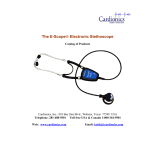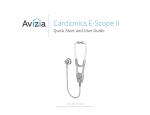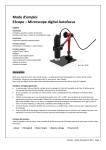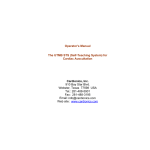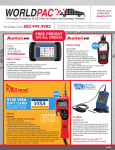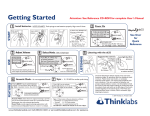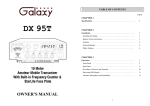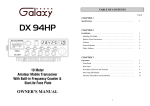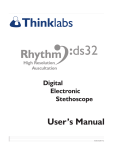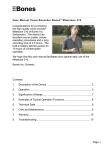Download E-Scope 7700 Electronic Stethoscope User`s Manual
Transcript
Operator’s Manual E-Scope® II Electronic Stethoscope Models: 718-7700, 718-7710, 718-7712, 718-7740, 718-7750 US Patent No. 5,025,809 Manual P/N: 014-7700, Revision F Date: June 2009 ® E-Scope is a registered trademark of Cardionics, Inc., Webster, Texas USA ™Specialist is a trademark of Cardionics, Inc. Note: U.S. Federal law restricts this device to sale on the order of a physician. IMPORTANT NOTE for Hearing Impaired Users. Please be aware that using the E-Scope with your hearing aid for auscultation of the heart, lungs or Korotkoff (blood pressure) sounds may be limited by the capability of your hearing aid or the interface between your hearing aid and the E-Scope Electronic Stethoscope. Heart Sounds have a frequency range of 20-650Hz while breath sound range form 70 to 2000Hz. Hearing aids are designed for enhancement of voice sounds that have a frequency range from approximately 500 to 4000Hz. Some hearing aids can be programmed for lower frequencies. However, even with this additional low frequency response, the hearing aid may still not be able to reproduce the heart and lung sounds adequately for diagnosis. Also, some individuals may have hearing loss in the range for heart and lung sounds that is not compensated by their hearing aid. For these reasons, Cardionics recommends that you consult with your audiologist for advice covering your hearing loss and the response of your hearing aid. We will be pleased to assist you or your audiologist. b Quick Setup Instructions: • Turning the E-Scope ON/OFF: Press any button on the head of the E-Scope to turn it on. There is not an “OFF” button on the unit. To turn the EScope off, simply wait approximately 1.5 minutes and the unit will automatically turn OFF. When restarted, the EScope will return to the last volume automatically. • Adjusting the Volume: There are 64 steps between the highest and lowest volume positions on the E-Scope II. The best way to adjust the volume is to press and hold the plus (+) or minus (-) buttons on the stethoscope head until the desired volume is achieved. • Switching between Heart and Breath Sounds. To switch between Heart/Breath Sounds, press the “n” key on the head of the E-Scope. The default mode is Heart Sounds. By blowing on the stethoscope head as you press the “n”, you can easily determine if you are in the heart or breath sound frequency mode. Breath sounds will sound higher. • Changing the Battery in your E-Scope Simply snap the “open” panel on the back of your unit. Replace battery with a fresh “AAA.” c Safety Precautions The following symbols are applicable to this device: No degree of protection against ingress of IPX0 water. Attention: Read and understand all warnings and cautions before use. Type BF Equipment. This equipment provides a high degree of protection against electric shock. Caution: The E-Scope should be used by qualified medical personnel only. Observe best practice. The instructions in this manual do not, in any way, supersede established medical procedures or staff preference concerning patient care. "Best Practice" as determined by the medical community is always to be observed. Do not operate this device in the presence of flammable anesthetics or other flammable gases. As a general safety precaution, this instrument should be turned off and battery disconnected before performing any cleaning procedures. Use only AAA alkaline batteries. Follow all warnings and instructions on the battery package including proper disposal of depleted batteries. d Cautions continued: At the end of the E-Scope useful life dispose or recycle in accordance with your local, state and governmental regulations. The E-Scope complies with electromagnetic compatibility (EMC) EN60601-1-2:2001. However, close proximity to a radio transmitter may result in interference heard through the E-Scope Binaural or headset. If this occurs, move away from the radio’s transmitting antenna. Do not immerse any part of the E-Scope in any liquid or subject it to any sterilization processes. Important note for hearing aid users: Hearing deficiencies vary considerably from person to person. Your audiologist is the best source of information on your particular hearing problem. You should consult with your audiologist if you have any specific questions about the use of your hearing aid with the E-Scope Electronic Stethoscope or any similar device. The information supplied by Cardionics for hearing impaired users should be considered as a general guideline only. The E-Scope has significant volume output. Do not turn on higher than required for normal listening. No serviceable parts. Do not attempt to repair or service the E-Scope. Return to Cardionics for any and all repairs. Call 281-488-5901 for service directions. e Contents Page No. 1.0 Product Description ................... ......................................1 1.1 Models and Accessories ...................... ...........4 2.0 Using the E-Scope................. ..........................................8 2.1 general clinical use.................. ........................8 2.2 for teaching.......................................................8 2.3 recording....................................... ...................8 2.4 in telemedicine .............. ..................................9 2.5 other applications ................ ............................9 3.0 Operation..........................................................................9 3.1 Volume Adjust.............................................. .....9 3.2 Filter Select ......................................................9 3.3 Power ..................... ..........................................9 3.4 Battery……………………………………………. .10 3.5 Sounds Output…………………………………… 10 4.0 Cleaning ................................ ..........................................12 5.0 Transport and Storage........... ..........................................12 6.0 Troubleshooting guide ..................... ................................12 7.0 Warranty .......... ................................................................13 8.0 Appendix................................................................. .........15 8.1 Recording Techniques ........................... .........15 9.0 Index....................................................................... .........17 List of Figures Figure 1 E-Scope clinical model ...................... ......................2 Figure 2 E-Scope belt model ....................... ..........................2 Figure 3 Wearing the E-Scope ........................ ......................3 Figure 4 Using the E-Scope ...................... ............................3 Figure 5 Headphone, Over the head style. ............................5 Figure 6 Headphone, Behind the head style ..........................5 Figure 7 Specialist Diaphragm .........................................….. 7 Figure 8 Specialist Bell…………………………………………..7 Figure 9 Specialist Pediatric Bell………………..…………...... 7 Figure 10 Accessory Pack……………………………………… 7 Figure 11 E-Scope Stethoscope head...................………….. 9 Figure 12 E-Scope Controls……..........................……………11 f 1.0 Product Description The E-SCOPE II is a second generation, patented, CE certified, electronic stethoscope. It allows the user to amplify or record heart and breath sounds. The E-Scope II is an electronic stethoscope featuring a slim-line design with the volume and filter controls on the head of the stethoscope. The slim design allows it to be draped comfortably around the neck. With the controls on the stethoscope head, the user will find the E-Scope easy and convenient to use. The sound quality is exceptional with 64 gain positions. There are many reasons for using an electronic stethoscope rather than an acoustic stethoscope: • • • • • • • The ability to hear soft sounds in a noisy environment, The ability to record, edit and play back any sound, The ability to send sounds over telephone lines for diagnosis by a specialist, The ability to send sounds by email for diagnosis by a cardiologist, The ability to compare a patient with him or herself at differing time intervals, The ability to filter the sounds so that only certain portions of The sound complex can be heard, The ability to teach students by having more that one simultaneous listener with a single patient, The E-Scope is supplied with a Specialist Adult Diaphragm that may be changed to a Specialist Adult or Specialist Pediatric bell. . Also supplied are plastic adult, infant and pediatric size bells and a selection of ear tips for maximum user comfort. The E-Scope is equipped with a timer that will turn the instrument off after approximately 1.5 to 2 minutes to conserve battery life. The E-Scope has an auxiliary output for connecting to a second listener or recording type device. 1 The E-Scope is designed to maximize hearing of heart and lung sounds. A sound selector switch is provided to allow listening in the proper frequency response for either heart sounds or breath sounds. There are several models of the E-Scope II. The clinical E-Scope (cat. no. 718-7740, 718-7700) and the Belt model E-Scope for hearing impaired users (cat. no. 718-7750, 718-7710). Figure 1 E-Scope II electronic stethoscope Clinical model Figure 2 E-Scope belt model for hearing impaired users The Belt model E-Scope is designed for use with an ITE (in-the-ear) type hearing aid. With the Belt model E-Scope, the normal earpieces have been removed. A pair of headphones are then inserted into the upper output of the E-Scope and placed over the hearing aids. Figure 2 shows the detail of the Belt model E-Scope and Figure 4 shows the E-Scope in use. 2 Figure 3 Wearing the E-Scope Figure 4 – Using the E-Scope 3 1.1 Models and Accessories Cat. no. Description Clinical Models 718-7700 E-Scope Electronic Stethoscope Clinical model with Specialist Adult Diaphragm 718-7740 E-Scope Electronic Stethoscope with Specialist Adult Diaphragm and Specialist Adult Bell Pediatric Model 718-7745 E-Scope Electronic Stethoscope (same as cat. no. 718-7740 above except also supplied with Specialist Pediatric Bell. Ambulance Model for High Noise Areas 718-7800 E-Scope EMS Electronic Stethoscope For use in an ambulance or high noise area. A separate Operator’s Manual is provided for the E-Scope EMS Hearing Impaired Models ITE (in-the-ear) or “open fit” BTE 718-7710 E-Scope Hearing Impaired (Belt) model. Supplied with Specialist Adult Diaphragm. This is the same as the E-Scope, cat. no. 718-7700, except that the ear pieces have been removed and a belt clip added. This model is designed for use with headphones (cat. no. 718-0405 or 718-0415). A headphone is included. 718-7750 E-Scope Belt model. This is the same as above cat. no. 718-7710 except it is supplied with both Specialist Adult Diaphragm and Specialist Adult Bell. 4 Accessories Cat. no. Description 718-0405 Over the head style headphone These headphones are designed for use with the E-Scope Belt model, cat. no. 718-7710 or cat. no 718-7750. Figure 5. Over the head style headphone. 718-0415 Behind the head style headphone These headphones are designed for use with EScope model 718-7710 and 718-7750. This style has a single cord and behind the head style fit. Figure 6. Behind the head style headphone. 718-0410 Stethophone The stethophone is designed for teaching to allow a second listener to hear simultaneously. 5 360-7740 360-7750 360-7755 Specialist™ Adult Diaphragm The performance of the Specialist Adult Diaphragm is, on average, about 3 dB or 40% better than a stamped metal diaphragm. Specialist Adult Bell Like the above Specialist Adult Diaphragm, the Specialist Adult Bell is machined from high-grade stainless steel. Its performance is superior allowing the listener to use the split finger technique by placing the bell between the index and middle finger thereby permitted gentle, controlled pressure to be applied. Specialist Pediatric Bell. The Pediatric Specialist Bell output is, on average, about 60% higher than a stamped metal pediatric bell over 50-200 Hz frequency range for both heart and breath sound filter settings. 6 Accessory Pack. Each E-Scope is supplied with an Accessory pack that contains a pediatric diaphragm, plastic adult bell, plastic pediatric bell and plastic infant bell. These chest pieces can be used by replacing the existing chest piece by unscrewing. Additionally, this pack contains both mushroom and hard plastic ear tips. Inserting he mushroom ear tips will require a little force. The hard plastic eartips are self-threading. Place this eartip on the stethoscope binaural, press and with a twisting motion, screw them on. Figure 7 Specialist Adult Diaphragm Figure 8 Specialist Adult Bell Figure 9 Specialist Pediatric Bell Figure 10 E-Scope Accessory kit Supplied with all E-Scopes Upper row left – adult plastic diaphragm, upper middle infant bell, upper right, mushroom eartips; Lower row – Pediatric diaphragm, pediatric plastic bell, hard plastic eartips. 7 Cable Connections Cat. no. Description 711-9000 Interface Cable. Connects to a PC or recording device that th accepts an 1/8 inch phone plug. 2.0 Using the E-Scope 2.1 To use the E-Scope, place the stethoscope on the patient in the normal manner as shown in Figure 4. Press any button on the head of the stethoscope to turn it ON. Press and hold the + button until the volume is at a desired level. The filter is automatically set for heart sounds. If you wish to change it to breath sounds, press the ● button on the stethoscope head (Note: If the ● button is pressed to activate the E-Scope then the filter will be in the breath mode). The E-Scope will turn OFF automatically after 1.5 to 2 minutes. To restart, press any button on the stethoscope head. The E-Scope retains the last volume setting and reverts to that setting when restarted. 2.2 For Teaching For teaching purposes, it is possible to have a second person listen to a patient simultaneously. Connect the stethophone (cat. no. 7180500) to the “sounds output” of the E-Scope. The student will hear what the instructor hears. 2.3 Recording Sounds We suggest you also review Appendix A in this manual for recording techniques. To record you will need a connecting cable (cat. no. 711-7128). 8 2.4 For Telemedicine Use The E-Scope may be used for sending heart and/or lung sounds over telephone lines or the internet using a recognized telemedicine system such as PolyCom or Tandberg systems. 2.5 Other Applications a. The E-Scope can be used for general clinical use in place of an ordinary acoustic stethoscope. b. Physicians or nurses with hearing impairment. c. Ambulances d. Emergency rooms e. Pediatric wards 3.0 Operation 3.1 Volume Adjust. The E-Scope volume may be increased or decreased by momentarily pressing the + or – button located on the stethoscope head. Pressing and holding one of these buttons for more than one second causes the volume to move up or down. It takes about seven seconds for this automatic adjustment to cover the full volume range of 64 steps. The EScope retains the last volume setting and reverts to that setting when the power is turned on. Figure 11 E-Scope Stethoscope head 3.2 Filter Select. The ● button on the stethoscope head alternately selects the heart or breath sound filter each time it is momentarily pressed. Pressing the ● button to power on the EScope initially selects the breath sound filter. Conversely, pressing either the + or – button to start power initially selects the heart sound filter. 3.3 Power. Pressing any of the buttons on the stethoscope head turns ON power to the E-Scope. The E-Scope has a timer that 9 shuts off power after approximately 1.5 to 2 minutes. The timer is restarted each time one of the switches is pressed. 3.4 Battery A single AAA battery powers the E-Scope. This battery will operate the E-Scope for approximately 4.5 months assuming it is used 30 times per day, 5 days per week. To change the battery, remove the battery cover by sliding it outward. Remove the old battery and install the new in the normal manner. 3.5 Sounds Output. This connector, located on the body of the EScope, allows accessory units to be attached to the E-Scope. See Figure 12. 4.0 Cleaning The E-Scope can be cleaned using a standard alcohol swab or wipe (70% Isopropyl Alcohol). Do not use excessive liquid or immerse any part of the E-Scope. Doing so may result in moisture getting inside the unit. 5.0 Transport and Storage The E-Scope can be safely stored or transported with the following environmental conditions: -20°C – 65°C (-4°F – 149°F), <95% relative humidity. 10 Figure 12 - E-Scope Controls Output Jack for Cardionics Headphone, Model 718-0405 and 718-0415. Cardionics R E-SCOPE Electronic Stethoscope SOUN OUTDS Increase or decre ases the volume. Press either button while the unit is off and it will power on in the heart sound mode by default and remain on for 1.5 minutes. The timer resets itself after every press of a button. When the E-Scope restarts, it returns to the last volume setting. Output for either second listener or accessory. + E C OP E -S Sets the ideal frequency for heart or lung sounds. Pressing the dot while the EScope is off will activate the unit and adjust for lung sounds. Press the dot while the E-Scope is active and it will toggle between lung and heart sound modes. 11 - 6.0 Troubleshooting Guide Possible Problem Cause / Solution(s) No power The E-Scope will turn off automatically after 1.5 to 2 minutes of use. Press any button on the stethoscope head to restart. If this does not restart the E-Scope, check the battery and replace if necessary. If the E-Scope still does not restart, please call Cardionics for assistance. Not enough volume Press and hold the + button on the head of the E-Scope. If using a hearing aid, the volume should be increased gradually while tapping the diaphragm lightly. Be sure that diaphragm is securely tightened on the threaded housing. Clicking noise or static Speaker driver is clipping. (1) reduce volume until clicking sound disappears. (2) battery may be depleted. Replace, if necessary (3) Use the bell of the stethoscope. (4) Using the – button on the stethoscope head, press and hold for 7 seconds. This takes the volume to zero. Then, press and hold the + button for 2-3 seconds. There are 64 gain positions on the E-Scope volume control. The above maneuver has adjusted the E-Scope to mid-range. Some additional adjustment may be necessary. For static, place the chest piece lightly on the chest. There may be an initial static sound that will quickly disappear. 12 7.0 Limited Warranty What this warranty covers: 1. Cardionics, Inc. warrants this product to be free of manufacturing defects in material and workmanship for a period of one (1) year from the date of original consumer purchase from Cardionics or an authorized dealer. 2. This written warranty is limited to the original consumer purchaser, transferable only by written authorization of Cardionics, Inc. 3. All warranties, expressed or implied, made by Cardionics, including warranties of merchantability and fitness are limited to the one (1) year period of this warranty. Some states do not allow limitations on how long an implied warranty lasts, so the above limitations may not apply to you. 4. This warranty is limited to repair of the product or replacement thereof, at the discretion of Cardionics, Inc. Calibration is considered normal maintenance and are not included in the one year warranty. What this warranty does not cover: 1. This warranty does not cover defects or damage resulting from use of the product other than its normal, intended and customary use. This warranty does not cover defects or damages from abnormal use, abnormal conditions, improper storage, exposure to moisture or liquid, unauthorized modifications, repairs made by unauthorized personnel, unauthorized connections (those not described in this manual), misuse, neglect, abuse, accident, alternation, improper installation or other acts which are not the fault of Cardionics, including damage caused by shipping. 2. E-Scopes which have had the serial number removed or made illegible. 3. Damage resulting from use of non-Cardionics approved accessories. 13 Policies concerning service. Shipping charges. The customer shall bear the cost of shipping the product to Cardionics. We suggest that you insure the package Authorization for return. Before sending equipment for repair, please call Cardionics, at 281-488-5901 or in the U.S. or Canada 1-800-3645901 for a return memo authorization number (RMA#). This will help us track your repair. Reason for return. Please include a note with your name, address, telephone and email address and what you believe the problem to be. Packing for return. Equipment requiring repair should be suitably packaged for shipping. Where to obtain service. Ship package prepaid to Cardionics, Inc., 910 Bay Star Blvd, Webster, Texas 77598 USA. We will endeavor to complete repairs within fifteen (15) working days from date of receipt of product by Cardionics. Out-of-warranty service. . When a product is returned for service that is out-of-warranty, Cardionics will call you to obtain your authorization prior to making the repair. We will ask for a credit card payment at the time of the call. If the repair is from an authorized Cardionics dealer or institution, Cardionics will ask for a purchase order number. Consequential Damages CARDIONICS, INC. SHALL NOT BE LIABLE FOR INCIDENTAL OR CONSEQUENTIAL DAMAGES ARISING FROM THE USE OR FAILURE OF THIS PRODUCT, INCLUDING INJURY TO PERSONS OR PROPERTY. Some states do not allow the exclusion or limitation of incidental or consequential damages, so the above limitations or exclusions may not apply to you. This warranty gives you specific legal rights, and you may also have other rights that may vary from state to state. 14 8.0 APPENDIX 8.1 Recording Techniques The user should recognize that listening to heart or breath sounds and recording them are different. Obtaining good recordings takes time and practice. To obtain a good recording, the stethoscope head should be taped to the patient. We suggest double-faced Scotch tape with a hole, (3M Double Stick Disks, part no. 2181). A hand touching the head of the stethoscope will introduce noise into the recording. Below are some additional tips on recording technique. 1. The room should be quiet. Many of the problems with recording heart sounds result from not having a quiet room. 2. The patient should be relaxed as much as possible. 3. For a thorough examination, the patient should be in a sitting, laying and left lateral recumbent position. For an adequate examination, the recumbent position alone can be used, but listening to the heart with the patient only in a sitting position is absolutely inadequate. Typical diastolic murmurs of good intensity that are heard when the patient is in the recumbent position may not be heard at all when the patient is sitting. In the recumbent position, the patient’s arms must not be held over the head, since this will elevate the rib cage and decrease the intensity of the heart sound. Occasionally, it is an advantage to listen with the patient in the prone position. This may be true in patients with deep chests or those who may have a friction rub. This position may be awkward when the patient is in bed or on the examining table and supporting himself/herself on the elbows. It is much better to have the patient stand up and lean over with his/her elbows on an examining table. Muscle noise is at a minimum in this position and the patient and examiner are much more comfortable. An important additional advantage of this position is that the patient can be made to exercise by touching his or her toes several times before he/she assumes the position. 4. When the bell of the stethoscope is applied to the skin, the enclosed skin forms a diaphragm. With increased pressure, the skin diaphragm is made taut and its natural period of oscillation increases. This improves the response to higher pitches, and at the same time there is a general lowering of the sensitivity of the skin diaphragm. As 15 a result, the lower-frequency components of the heart sounds are attenuated, whereas the higher frequencies are still well heard. This important maneuver of being able to diminish the intensity of lowpitched sounds, by pressure on the bell has several implications and applications: a. To hear faint, low-pitched sounds, the examiner must apply the bell lightly to the chest wall. b. By noting what happens to a sound or murmur when the bell is first applied lightly, and then with pressure, the examiner can judge, to a certain degree, the pitch of a sound or murmur. c. The high-pitched systolic murmur of mitral regurgitation is less likely to be affected by pressure than medium-pitched, innocent systolic murmurs. d. With pressure, the faint, high-pitched, systolic murmur of mitral regurgitation is less affected than the first heart sound, and the masking effect of the first heart sound is thus diminished. The same is true of the high-pitched, early diastolic murmur of aortic regurgitation and accentuated second heart sound. 16 8.0 Index Accessories ..........................5 Accessory pack.....................7 Battery ........................ c, d, 10 Cable, Recording ..................8 Cleaning........................10, 12 EMS, E-Scope ......................4 Filter..................................8, 9 Pediatrics, E-Scope in...........9 Headphones .........................5 Other E-Scope Applications..9 Power..................................10 Product Description ..............1 Recording sounds .................8 Recording Techniques ........16 Recycle .................................e Safety Precautions................d Sounds Output ....................10 Specialist Adult Bell ..............6 5, 6 Specialist Pediatric Bell.4, 6, 7 Stethophones........................5 Teaching with E-Scope .........8 Telemedicine, E-Scope in .....9 Transport and Storage ..10, 12 Troubleshooting ..................12 Uses of E-Scope ...................9 Using the E-Scope ................8 in Telemedicine.................9 Volume...................... c, e, 8, 9 Warranty .............................14 17
























